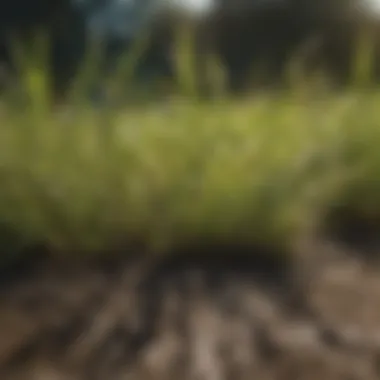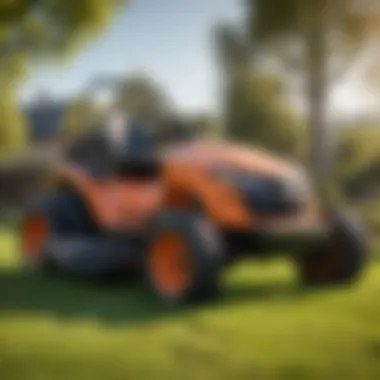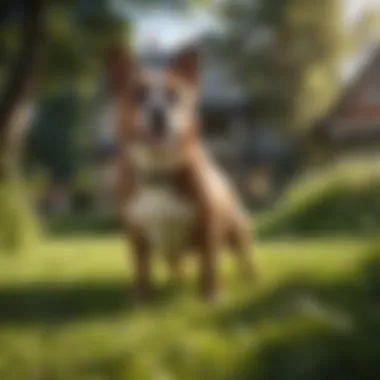Restoring Your Lawn: Recovering Grass from Dog Urine


Intro
Maintaining a healthy lawn can be a challenge, especially for pet owners. Dog urine is a common cause of grass damage, leading to unsightly brown patches and unhealthy turf. Understanding the effects of dog urine on your lawn is critical for effective recovery. In this article, we will explore the biochemical impact of dog urine and discuss various strategies to restore your lawn. This piece is intended for agriculture farmers and lawn care enthusiasts who seek to maintain a vibrant outdoor space despite the challenges posed by their furry companions.
Key Concepts and Terminology
Basic Definitions
To comprehend the recovery process, it’s essential to understand some key terms. Nitrogen is a primary component found in dog urine. While it is beneficial for grass growth in moderation, excess nitrogen can lead to leaf burn, disrupting the delicate balance necessary for healthy turf. Additionally, pH levels are a significant factor. Dog urine can elevate soil pH, resulting in conditions that are unsuitable for grass growth.
Historical Context
The relationship between pets and landscapes has existed for centuries. Traditionally, resources were available that discussed pet waste management, but the focus on lawn restoration from dog urine damage is relatively new. In modern times, urban living has increased the prevalence of pet ownership, leading to more attention on how to maintain lawns in pet-friendly areas. This shift has opened the door for newer innovations and practices aimed at addressing dog urine damage.
Recent Innovations and Trends
Technological Advancements
Recent development in lawn care tools has made managing pet-related issues easier. Products equipped with smart technology can monitor soil moisture and nutrient levels, providing insights into grass health. Additionally, research on fertilizers with balanced nutrients is progressing, allowing for tailored solutions that minimize dog urine impact.
Sustainable Practices
Sustainability is a growing trend in various industries, including landscaping. The use of organic fertilizers can provide a safe and effective alternative to conventional fertilizers, ensuring that the lawn can recover while benefiting the environment. Many homeowners are now opting for practices that not only restore their lawn but also contribute positively to the ecosystem.
Practical Applications and Techniques
Step-by-step Guides
Restoration of your lawn requires a systematic approach. Here’s a simplified guide:
- Assessment: Evaluate the extent of the damage. Identify the areas most affected.
- Soil Testing: Conduct soil tests to determine pH and nutrient levels.
- Preventive Measures: Use barriers or training techniques to minimize future damage caused by urine.
- Reseeding: Reseed the affected areas with appropriate grass varieties.
- Regular Maintenance: Implement a consistent lawn care routine that includes watering, mowing, and fertilizing as needed.
Case Studies
Observing successful lawn restorations can inspire actions. For instance, a community park in a pet-friendly area utilized a combination of organic fertilizer and careful reseeding, resulting in a lush lawn within a few months. This demonstrates that with proper management, recovery is very much achievable for any green space.
"A healthy lawn can coexist with pets if effective strategies are applied consistently."
By understanding the critical aspects of dog urine damage, employing the necessary recovery techniques, and implementing sustainable practices, your lawn can thrive amid the challenges posed by pets. A commitment to ongoing care will not only restore your grassy areas but also contribute to the overall health and beauty of your outdoor environment.
Understanding the Impact of Dog Urine on Grass
Understanding the impact of dog urine on grass is essential for anyone looking to maintain a healthy lawn in a pet-friendly environment. Dog urine contains a variety of chemical components that can significantly alter the health of turf. Recognizing these effects can lay the groundwork for effective restoration strategies. Moreover, pet owners must appreciate how the acid in urine can disturb the soil environment, influencing the overall growth and appearance of grass.
In this section, we will explore the specific chemical makeup of dog urine, how it impacts soil pH, and the vulnerabilities of different grass types. These insights will help you comprehend both the challenges and feasible solutions to reversing the damage caused by dog urine.
Chemical Composition of Dog Urine
Dog urine is primarily composed of water, urea, creatinine, uric acid, and other waste products. Each of these elements plays a part in its effect on grass and soil. Urea, for instance, serves as a nitrogen-rich nutrient but can become problematic in concentrated amounts. When too much nitrogen is applied to the grass, it can lead to burning and, ultimately, a dead patch. While dogs need to urinate, the varying concentrations depend on factors such as hydration level and dietary composition.
Moreover, uric acid in urine can crystallize, adding to the problem. Collectively, these chemical constituents produce a unique effect that is essential for recovery strategies.
How Urine Affects Soil pH


The pH level of soil plays a significant role in nutrient availability and microbial activity. Dog urine tends to increase soil acidity due to its nitrogen content. This change in pH can inhibit grass growth and promote the proliferation of weeds. For instance, if the soil becomes excessively acidic, some grass types may struggle to thrive.
To address this issue, monitoring soil pH is crucial. Testing kits can provide insight into whether your soil leans too acidic. When the pH is found to be low, lime application can be an effective remedy to neutralize the acidity.
Grass Type Vulnerabilities
Not all grasses respond to dog urine in the same way. Various species possess differing tolerances to environmental stressors. For example, Kentucky bluegrass is known to be particularly sensitive to urine damage, showing discoloration and wilting upon exposure. On the opposite end, fescue varieties tend to withstand the effects of dog urine better.
Choosing the right grass type can play a significant role in reducing the impact of dog urine. Drought-resistant or resilient varieties may reduce the likelihood of damage. Evaluation of grass options should include understanding your local climate and soil conditions for the best outcomes.
"Choosing a robust grass type can mitigate some of the adverse effects of dog urine damage and promote a healthier lawn overall."
Assessing these vulnerabilities enables dog owners to make informed choices about their lawn care strategies. By acknowledging the chemical landscape, soil dynamics, and grass species, you can put a plan in place that mitigates damage from dog urine effectively.
Identifying Symptoms of Damage
Recognizing the symptoms of grass damage resulting from dog urine is crucial for any lawn enthusiast. By identifying these signs early, effective recovery strategies can be implemented. This section examines the different indicators of dog urine damage, helping you understand what to look for in your yard.
Discoloration Patterns
Discoloration is one of the most evident symptoms of damage from dog urine. Affected areas often appear yellowed or brown. The pet's urine contains nitrogen, which can cause grass to burn when concentrated in specific spots. The grass around the area frequently stays healthy, creating contrasting patches that may become more prominent over time.
- Common patterns include:
- Circle shapes where the dog tends to urinate often.
- Random splashes where urine hits the grass at various angles.
- Patches that become larger if not addressed quickly.
Observing these patterns can allow homeowners to differentiate between normal grass wear and dog-related damage, guiding recovery efforts more effectively.
Wilting and Browning
Wilting is another significant indicator of stress in grass due to dog urine. The grass blades may lose their rigidity and appear limp, resulting from the high salt concentration in urine. Prolonged exposure can cause browning, a strong sign of distress.
- Specific signs of wilting include:
- Leaves that curl at the edges.
- Grass that feels soft or mushy instead of firm.
Wilting can also indicate a need for additional water or a more balanced soil chemistry. Understanding these signs helps you manage lawn recovery, ensuring that the grass receives the right care.
Areas Prone to Damage
Some areas of the lawn are more at risk for damage from dog urine than others. Typically, these are spots where your dog frequently visits, often influenced by their favored places to relieve themselves. High-traffic zones, such as those close to fences or pathways, may show quicker signs of damage.
- Common areas prone to damage:
- Near fences or walls where dogs spend time.
- Locations where dogs typically play or run.
- Outdoor structures like patios or decks that confine movement.
Recognizing these zones is essential to preventing extensive damage in the future. Monitoring these areas allows for timely intervention, essential in keeping your lawn healthy.
Detailed Recovery Techniques
Restoring a lawn damaged by dog urine is a multi-faceted process. Effective recovery techniques are essential for regaining a healthy appearance and integrity of the grass. These strategies focus on improving the health of the soil, enhancing grass resilience, and ensuring overall lawn vitality. Employing these detailed recovery techniques will help in minimizing future damage and promoting a lush green lawn.
Watering Strategies
Watering is a fundamental element in lawn recovery after urine damage. Proper watering can dilute the concentration of nitrogen in urine, which is a major contributor to grass burn. Consider the following strategies for watering:


- Immediate Irrigation: After noticing damage, watering the affected area immediately can help reduce the burning effect of urine. Aim for at least one inch of water to sufficiently soak the soil.
- Deep Watering: Watering deeply encourages strong root development. Use a soaker hose or sprinklers for even moisture distribution, ensuring the grass roots are hydrated.
- Frequency Control: Light, frequent watering can lead to shallow root systems. Adjust your watering schedule to allow the soil to dry out slightly between watering sessions, promoting deeper root growth.
Fertilization Methods
Fertilization comes into play not just to replenish nutrients but to support recovery from urine damage. It is vital to use fertilizers judiciously, as over-fertilizing can exacerbate the issues:
- Balanced Fertilizers: Use a balanced fertilizer that includes equal portions of nitrogen, phosphorus, and potassium. This helps restore nutrient balance in the soil.
- Organic Options: Organic fertilizers such as compost or well-rotted manure can enrich the soil naturally. They provide slow-release nutrients and improve soil structure.
- Timing: Fertilize during the active growing season for the grass species in your lawn. This leads to optimal nutrient uptake and growth, aiding recovery after damage.
Soil Amendment Approaches
Amending the soil is essential to enhance its structure and nutrient-holding capacity, which can be significantly impaired after exposure to dog urine:
- pH Testing: Conduct a soil pH test. Dog urine often raises soil pH, making it more alkaline. Calcium sulfate or elemental sulfur can help to restore balance if necessary.
- Compost Addition: Incorporate compost into the top inch of soil to improve aeration and provide beneficial microorganisms. This will also help retain moisture around the grass roots.
- Mulching: A layer of mulch can help regulate soil temperature and moisture. Choose organic mulch materials, as they decompose and enrich the soil over time.
Reseeding Techniques
Reseeding might be necessary for severely damaged areas. This involves planting new grass seed to fill in bare patches and promote recovery:
- Choosing the Right Seed: Select a grass seed variety suited for your climate and lawn conditions. Kentucky bluegrass and tall fescue are common choices that can help establish resilience.
- Methodical Reseeding: Lightly rake the damaged areas to prepare the seedbed. Spread seeds evenly and cover lightly with soil or compost to protect from birds and promote germination.
- Water and Monitor: Once reseeded, keep the area moist until the seeds germinate. Monitor closely for signs of growth and adjust watering based on weather conditions.
Restoring your lawn requires patience and dedication. Every step taken reinforces the health of the grass and soil.
Effective recovery from dog urine damage entails a careful combination of watering, fertilization, soil amendment, and reseeding techniques. Each method contributes to a healthier lawn capable of enduring pet-related challenges in the future.
Preventive Measures to Protect Your Lawn
Establishing preventive measures is essential for maintaining a healthy lawn, particularly in households with dogs. Once damage occurs due to dog urine, recovery can be labor-intensive and time-consuming. Implementing effective strategies from the start not only mitigates damage but also promotes a resilient lawn. The following measures can assist in safeguarding your grass against future harm.
Training Your Dog for Designated Areas
One of the most impactful preventive steps is to train your dog to relieve itself in specific areas. This can be accomplished through consistent routines and positive reinforcement. Identifying a part of the yard that is less visible or where grass is less desired can help concentrate the impact of dog urine in that area, thereby protecting the more visible sections of your lawn. Additionally, consider using commands to guide your dog to these designated spots. For dogs that are particularly stubborn, using a leash during bathroom breaks helps ensure they stay in the intended area. Over time, they will adjust to this new behavior, contributing to better preservation of your lawn.
Creating a Splash Zone with Alternative Surfaces
Another practical approach involves creating splash zones using alternative surfaces. By utilizing materials such as gravel, mulch, or artificial turf, dogs have spaces that are more forgiving of urine exposure. When setting up these zones, choose areas that are easily accessible and convenient for both the dog and the owner. This solution not only protects your grass but also keeps your lawn looking neat and well-kept. These alternative surfaces can be more easily cleaned and maintained. Thus, they serve as a practical solution that satisfies both the needs of pet owners and the aesthetic of the yard.
Increasing Lawn Resilience through Choice of Grass
Choosing the right type of grass can significantly enhance your lawn's resilience against urine damage. Certain grass varieties, like Perennial Ryegrass and Fescue, have more robust qualities that enable them to recover faster from environmental stressors, including dog urine. When selecting grass, consider local climate and soil conditions to ensure a favorable growth environment. It is also wise to consult with local horticulturists or extension services for recommendations on which types of grass thrive in your area. A well-chosen grass type not only withstands the occasional stress from pet urine but also promotes overall health and aesthetics of the lawn.
Key Reminder: Prevention is always easier and more effective than recovery. Proper training for your dog, creating splash zones, and selecting resilient grass types can protect your lawn in the long run.
Monitoring the Effectiveness of Recovery Efforts
Monitoring the health of your lawn post-recovery is not merely a beneficial action, but a vital necessity. With various factors involved in the recovery process, it is important to stay informed about the condition of your grass. Having a systematic approach to monitoring allows for timely adjustments in strategies, ensuring optimal recovery and health of the turf. This section delves into the key aspects of monitoring recovery efforts, emphasizing its benefits and underlying considerations.
Regular Lawn Health Assessments
Conducting regular health assessments of your lawn can provide crucial insights into its recovery journey. This involves physical examinations and observations of the grass. Look for signs of green renewal, density, growth patterns, and general health.
A structured schedule for assessments can be established, perhaps monthly, to keep track of changes.
- Check plant vigor: Is the grass regrowing? Inspect for lush green patches and overall thickness.
- Observe discoloration: Note if brown or yellow spots persist. This could signal ongoing issues.
- Evaluate soil conditions: Effective recovery partially depends on healthy soil. Ensure the soil remains aerated and well-drained.
Each assessment should also involve a comparison with previous conditions seen in the lawn. Any noticeable improvements or setbacks should be documented to inform further actions. Constant monitoring helps in determining whether interventions are working as intended or need modifications.


Documentation of Progress and Changes
Keeping a comprehensive record of progress enables a clearer understanding of what recovery efforts yield positive results. Documentation can take the form of photographs, notes, or charts, capturing the daily or weekly evolution of lawn health. The following should be included:
- Photographic records: Visual documentation can show before-and-after scenarios. This also helps to capture subtler changes over time.
- Data on weather conditions: Changes in weather can influence grass recovery. Keeping track of rainfall, temperature, and other factors can provide context.
- Fertilizer and watering logs: Record the types and amounts of fertilizers used, as well as watering schedules. This will help to correlate practices with observed improvements.
By implementing consistent and detailed documentation practices, you create an invaluable resource. This not only aids in understanding current recovery but can also serve as a reference for future lawn care strategies.
"The path to a stunning lawn is not linear; it requires observation and calculation to yield results."
Overall, monitoring the effectiveness of recovery efforts is integral to achieving a vibrant lawn. With regular assessments and thorough documentation, you can identify the best approaches for your specific situation, leading toward a successful restoration of your grass.
Understanding and Managing Urine Burn
Understanding and managing urine burn is a critical aspect of restoring a lawn affected by dog urine. This topic provides insights into the chemical reactions that occur when urine interacts with grass and soil. Recognizing urine burn can help lawn care enthusiasts implement effective recovery strategies to maintain a robust and healthy lawn.
Defining Urine Burn
Urine burn occurs when grass is exposed to high levels of nitrogen and salts present in dog urine. As these substances seep into the soil, they can disrupt the delicate balance needed for grass health. The result is often a patchy, discolored lawn with dead or dying grass blades.
This process can create areas that are significantly darker near the edges, with lighter centers where the grass has reacted adversely.
The key elements to consider are:
- Nitrogen saturation: While nitrogen is essential for grass growth, excessive amounts lead to "burn" patches.
- pH disruption: Dog urine can alter the soil pH, which impacts nutrient availability.
- Immediate assessment: Identifying these signs quickly can save larger sections of your lawn.
Seasonal Variations in Damage
The degree of urine burn can vary by season, influenced by weather and environmental conditions. In warmer months, for instance, the heat can exacerbate the effects of urine burn due to increased evaporation and concentrated nutrients in the soil. Over time, this intensifies grass stress and leads to further damage. Conversely, cooler seasons can slow down the urine degradation process, and lawns may show delayed symptoms.
Some important points to keep in mind include:
- Temperature fluctuations: High temperatures can accelerate evaporation, concentrating urine components in the soil.
- Rainfall impact: Heavy rainfall can dilute uric components but may also wash them deeper into the soil, affecting roots indirectly.
- Grass recovery: Cooler temperatures may allow for a stronger recovery period, as plant stress is lower.
Awareness of these seasonal variations allows homeowners and gardeners to manage their lawns more effectively. It is essential to observe the lawn regularly for signs and respond promptly to mitigate long-term damage.
Expert Insight: Consulting a Lawn Care Professional
When dealing with lawn damage related to dog urine, the expertise of a lawn care professional can be invaluable. Often, the damage can be more extensive than it appears, extending beneath the surface or affecting surrounding areas. A professional can assess the situation quickly and accurately, determining the best course of action based on the specific conditions of your lawn. Their experience allows them to identify issues that a homeowner may overlook, such as soil compaction or pest infestations that can complicate recovery efforts.
Moreover, consulting a professional brings the benefit of tailored advice, specific to your type of grass and local climate. They can provide comprehensive strategies that not only address current damage but also help prevent future incidents. Some may offer soil testing services to analyze nutrient levels and pH, leading to a more precise restoration plan. This can save time and resources in the long run, providing a clearer pathway to a healthy lawn.
"A lawn care professional can objectively evaluate lawn health and recommend effective recovery strategies tailored to individual conditions."
When to Seek Professional Help
Recognizing the right moment to seek professional assistance is key. If you notice persistent yellow patches that do not improve with standard recovery techniques like increased watering or reseeding, it might be time to consult a specialist. Additionally, when there is a notable increase in barren spots or die-off areas, this could indicate deeper issues. Other signs to consider include:
- Rapid decline of overall lawn health.
- Presence of pests or diseases.
- Soil pH levels that are difficult to manage.
While some lawn care can be handled through personal effort, situations that fall outside of typical recovery methods necessitate a deeper level of professionalism.
Finding the Right Lawn Care Specialist
Selecting an appropriate lawn care specialist requires careful consideration. You should start by researching local professionals who have experience specifically with dog urine restoration techniques. Online platforms and community forums like Reddit can provide insightful reviews and recommendations.
Additionally, factors to consider include:
- Certifications and expertise in lawn care.
- References or past case studies showcasing their success.
- Proposed methods and the science behind their strategies.
It’s important to have an initial consultation where you can discuss your lawn's specific issues and the potential approaches the expert may take. This conversation should include inquiries about their approach to soil testing and any follow-up services they offer. Always ensure that the chosen specialist fits your needs and budget before making a commitment.















